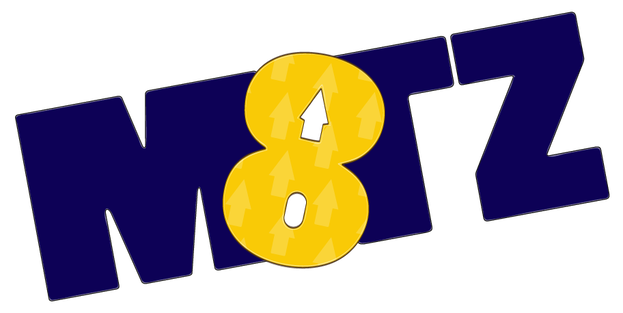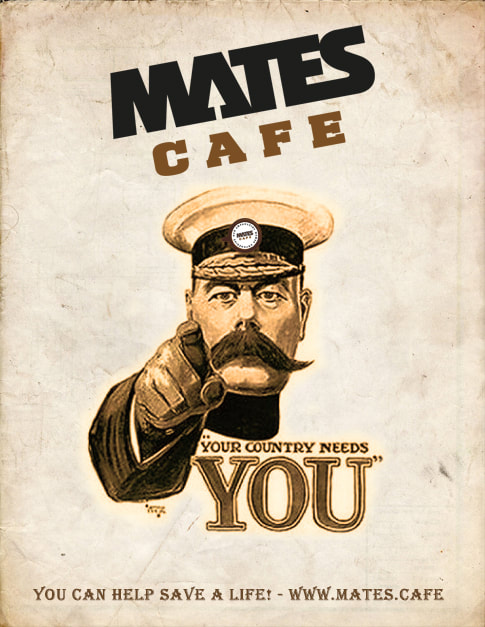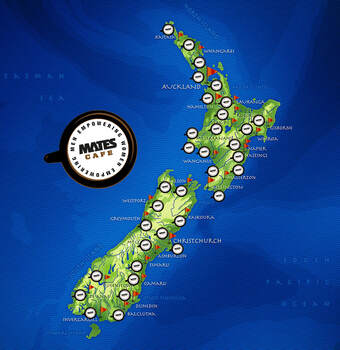You Are Not Alone - MATES Cafe West Coast NZ
MATES Cafe is a network of everyday people of all cultures and ethnicity (including teens, elders and lgbt+) who are trained to meet with a person in crisis or isolation at a local cafe, and provide emotional support and encouragement.
MATES Cafe will empower your life so you can in turn empower the lives of others in need.
MATES are here:
To help people of all ages, gender, culture, ethnicity and personal beliefs through the challenges and tough times of life including relationship breakdown, depression, anxiety, loss and grief, bullying, loneliness and isolation. MATES are trained to be there for someone in need and helping them through a point of crisis in their life. It's not about therapy, fixing or giving advice, just simply listening and helping them to find new direction in their life.
West Coast NZ - MATES Cafe Network
|
A Call-Out to ALL!
Can You Spare ONE Hour of Your Life to Save a Life? MATES Cafe is purely about saving lives. Do you realise one person completes suicide every 13 hours in New Zealand because they are unable to stand the emotional trauma they are undergoing, often caused by relationship breakdown. Every 4 minutes 1 New Zealander has suicidal thoughts and needs a MATE to turn to. MATES need your help to drastically lower the suicide rate... are you with us? Saving someones life can be to either:
|
Support Services in West Coast Region
LifeLine New Zealand Last updated 06/06/2013 LifeLine is here to listen to the unheard, to empower the caller to retake control of their situation, making callers aware of options rather than offering advice.
This provider offers a national helpline service.
- [email protected]
- (0800) 543 354
- (0800) LIFELINE
- http://www.lifeline.co.nz
- Availability: 24 hours a day, seven days a week.
- Charges: All services free of charge.
- Referrals: No referral required.
This provider offers a national helpline service.
- [email protected]
- (0800) 111 757
- http://www.depression.org.nz
- Availability: Helpline is available 8am to midnight daily. Website is available 24 hours a day, seven days a week.
- Charges: All services free of charge.
- Referrals: No referral required.
- [email protected]
- (0800) VICTIM
- (0800) 842 846
- http://www.victimsupport.org.nz
- Availability: The Victim Support Service is available 24 hours, 7 days a week
- Charges: All services free of charge.
- Referrals: No referral required.
Approved Family Violence Provider
- [email protected]
- (03) 789 8025
- (0800) 733 843 REFUGE
- http://www.womensrefuge.org.nz
- Availability: 24 hour crisis line 0800 733 843 REFUGE
- Charges: All services free of charge.
- Referrals: Referral may apply.
- [email protected]
- (0800) VICTIM
- (0800) 842 846
- http://www.victimsupport.org.nz
- Availability: The Victim Support Service is available 24 hours, 7 days a week.
- Charges: All services free of charge.
- Referrals: No referral required.
SHINE: Safer Homes In New Zealand Everyday Inc Last updated 04/10/2012 Shine (Safer Homes In New Zealand Everyday) is making homes violence free. Shine offers a free national Helpline and a number of innovative services that work to stop domestic abuse.
This provider offers a national helpline service. Approved Family Violence Provider
- [email protected]
- (0508) 744 633
- (09) 815 4601
- http://www.2shine.org.nz
- Ground Floor
- 409 New North Road
- Kingsland
- Auckland
- Availability: Helpline ( 0508 744 633 ) is answered 9am - 11pm, 7 days a week . Our office hours are 8.30am - 5.00pm weekdays.
- Charges: Some charges may apply.
- Referrals: Referral may apply.
Need Further Support - Click Here
Information about West Coast
Number of people counted
Total population
- 31,326 people usually live in West Coast Region. This is an increase of 1,026 people, or 3.4 percent, since the 2001 Census.
- Its population ranks 16th in size out of the 16 regions in New Zealand.
- West Coast Region has 0.8 percent of New Zealand's population.
- Male 15,912 1,965,618
- Female 15,417 2,062,329
- Total 31,326 4,027,947
- 2,916 Māori usually live in West Coast Region, an increase of 369 people, or 14.5 percent, since the 2001 Census.
- Its Māori population ranks 16th in size out of the 16 regions in New Zealand.
- 0.5 percent of New Zealand's Māori population usually live in West Coast Region.
- Male 1,461 274,860
- Female 1,455 290,469
- Total 2,916 565,326
Number of dwellings counted
- There are 13,020 occupied dwellings and 2,313 unoccupied dwellings in West Coast Region.
- For New Zealand as a whole, there are 1,478,709 occupied dwellings and 159,276 unoccupied dwellings.
- There are 144 dwellings under construction in West Coast Region, compared with 13,557 under construction throughout New Zealand.
- Occupied Private dwelling 12,768 1,471,746
- Non-private dwelling 249 6,963
- Total 13,020 1,478,709
- Unoccupied 2,313 159,276
- Under construction 144 13,557
- Total 15,477 1,651,542
West Coast Region
The West Coast (Māori: 'Te Tai Poutini') is one of the administrative regions of New Zealand, located on the west coast of the South Island, and is one of the more remote and most sparsely populated areas of the country. It is made up of three districts: Buller, Grey and Westland. The principal towns are Westport, Greymouth and Hokitika.
Naming
- To New Zealanders, 'The Coast' generally refers to the West Coast of the South Island, and 'Coasters' to those that live there.[2][3]
- 'Westland' is used by some New Zealanders to refer to the whole of the West Coast, including Grey District, Buller District, and Fiordland,[citation needed] and can also refer to the short-lived Westland Province of 1873–76.
- Fiordland is geographically on the west coast of New Zealand but has no direct road connection, and is in the Southland rather than West Coast administrative region.
Pancake Rocks, Punakaiki, West Coast The land is very scenic, with wild coastlines, mountains, and a very high proportion of native bush, much of it native temperate rain forest. The West Coast is the only part of New Zealand where significant tracts of lowland forest remain-elsewhere, for instance on the Canterbury Plains and in the Firth of Thames, they have been almost completely destroyed for settlement and agriculture. Scenic areas include the Haast Pass, Fox and Franz Josef Glaciers, the Pancake Rocks at Punakaiki and the Heaphy Track.
The region has a very high rainfall due to the prevailing northwesterly wind pattern and the location of the Southern Alps – these two elements give rise to heavy orographic precipitation. The flip side to this is the rain shadow effect which is responsible for the relatively arid climate of the Canterbury Plains on the other side of the Southern Alps.
The region's area is 23,000 km². It is divided into the three districts of Buller, Grey and Westland.
Economy The sub-national GDP of the West Coast region was estimated at US$779 million in 2003, 1% of New Zealand's national GDP.[4]
History Dillmanstown, a gold mining town on the West Coast. The West Coast was home to Māori, who valued it for the greenstone (pounamu) which was found there in abundance.
The West Coast was only occasionally visited by early Europeans until the discovery of gold near the Taramakau River in 1864 by two Māori, Ihaia Tainui and Haimona Taukau. By the end of the year there were an estimated 1800 prospectors on the West Coast, many of them around the Hokitika area, which, in 1866, became briefly the most populous settlement in New Zealand.
The present-day region of the West Coast was divided between Nelson Province and Canterbury Province from 1853, but in 1873 the Canterbury portion of the region formed its own province, the Westland Province, until the abolition of the provincial system in 1876.
The West Coast Gold Rush between 1864 and 1867 created numerous gold rush towns such as Okarito which at one time was the largest town on the West Coast but then quickly almost vanished as miners moved on. After that time, the population dwindled, but the main towns that still exist on the coast had become established.
Following greenstone and gold, the next mineral to make the West Coast valuable was coal. Discovered near the Buller River in the mid 1840s, mining began in earnest during the 1860s. By the 1880s, coal had become the region’s main industry, with mines throughout the northern half of the region, especially around Westport. Many of these continued in operation until the mid 20th century, and several survive today.
Timber has also long been a major industry in the region, although in recent years there has been an uneasy balance between forestry for wood and forestry for conservation. Much of the region is public land administered by the Department of Conservation and the region has some of the best remaining stands of native forest, along with a wealth of rare wildlife. Ecotourism is now an important industry in the region, and this goes hand in hand with the conservation efforts.
Habitation Human Typical rugged coastline of the West Coast. Typical weather of the West Coast. The region is sparsely populated, especially in the south, with the 2006 census recording 31,326 inhabitants, up from 30,303 in 2001, although not as high as the 1996 figure.
Westland Snowflake Ice Cream Factory at Coal Creek - closed in the early 1990s by a fire caused by lightning strike! Major towns on the West Coast are Greymouth, Westport, and Hokitika. At one time, during the gold rush days, Hokitika had a population of more than 25,000 and boasted more than 100 pubs. A recreation of an early New Zealand settlement can be found at Shantytown.
Industries on the West Coast include mining for coal and alluvial gold, forestry and wood processing, and also fishing (including whitebaiting), tourism and farming. Dairy farming has grown strongly – the local dairy co-operative Westland Milk Products remained independent when most others merged to form Fonterra in 2001. Other industries are the manufacturing and sales of greenstone jewellery, sphagnum moss gathering and stone-collection for garden landscaping. The West Coast also has one of the strongest growing regional economies of New Zealand, as of 2007,[5] though from a rather small base.
The West Coast has been numbered amongst the "Top 10 Coastal Drives of the World" by Lonely Planet.[6]
West Coast warning sign Flora and fauna The West Coast is also notable for being the only New Zealand nesting place of the White Heron / Kotuku, which nests near the Okarito Lagoon and can be visited from tours operating out of the small farming township of Whataroa. This rare bird appears on the New Zealand $2 coin
Realizing our full human potential... Imagine what we can achieve together!
M8TZ - Recreating Community: Worldwide | New Zealand | Australia | United States | United Kingdom | China | Canada | India
Refer Someone | Consultations | Contact M8TZ Cafe: | Policies | © MATES 2023 All rights reserved.
Refer Someone | Consultations | Contact M8TZ Cafe: | Policies | © MATES 2023 All rights reserved.






